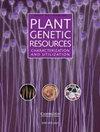Assessment of genetic diversity and population structure of Indian common bean accessions using microsatellite markers
IF 0.7
4区 生物学
Q3 PLANT SCIENCES
Plant Genetic Resources: Characterization and Utilization
Pub Date : 2023-08-29
DOI:10.1017/s1479262123000606
引用次数: 0
Abstract
Common bean (Phaseolus vulgaris L.) is an important crop of family Fabaceae used as a potential source of proteins, fibres and minerals. Thus, characterization of existing germplasm is useful for improvement and conservation. The Indian Himalayan Region harbours plentiful varieties of common bean, but it is nearly unexplored till date. In the present study, physical and genetic diversity of common bean was examined. Fifteen newly designed chloroplast microsatellite (cpSSR) markers were used to assess genetic diversity and population structure in 119 common bean individuals from 20 diverse accessions gathered from Uttarakhand, India. Significantly, positive (p< 0.05) relationship of seed weight was found with seed length (r = 0.813), seed width (r = 0.692) and seed length- width ratio (r = 0.694) using Pearson correlation analysis. A total of 20 alleles were identified using eight cpSSR markers. Mean number of alleles per locus (Na = 1.55), effective allele number (Ne = 1.370), expected heterozygosity (He = 0.213), average polymorphic loci (10.9) and Shannon information index (I = 0.313) were estimated based on cpSSR data. Maximum genetic diversity (He) was recorded in the AKJ/KK/DP/Jhalla/23 accession and minimum in the AKJ/YB/PS/Supi/43 accession. Bayesian-based STRUCTURE evaluation using cpSSR-based information partitioned 20 accessions into two distinct clusters which were also supported by neighbor-joining cluster analysis. These cpSSR markers also demonstrated transferability among other members like Vigna radiata, Macrotyloma uniflorum, Glycine max, Vigna mungo of Fabaceae family, therefore can be used to monitor their genetic heterogeneity. The findings from the study might be valuable to identify elite common bean accessions for production, conservation and future breeding programmes.利用微卫星标记评价印度菜豆遗传多样性和群体结构
菜豆(Phaseolus vulgaris L.)是豆科植物中的一种重要作物,是蛋白质、纤维和矿物质的潜在来源。因此,对现有种质资源进行鉴定有助于改良和保护。印度喜马拉雅地区拥有丰富的普通豆品种,但迄今为止几乎未被开发。本研究对普通豆的物理和遗传多样性进行了研究。利用15个新设计的叶绿体微卫星(cpSSR)标记,对采集自印度北阿坎德邦的20个不同菜豆材料的119个普通豆个体的遗传多样性和群体结构进行了分析。经Pearson相关分析,种子重与种子长(r = 0.813)、种子宽(r = 0.692)、种子长宽比(r = 0.694)呈正相关(p< 0.05)。利用8个cpSSR标记共鉴定出20个等位基因。利用cpSSR数据估计了每个位点的平均等位基因数(Na = 1.55)、有效等位基因数(Ne = 1.370)、期望杂合度(He = 0.213)、平均多态位点(10.9)和Shannon信息指数(I = 0.313)。遗传多样性在AKJ/KK/DP/Jhalla/23组合中最高,在AKJ/YB/PS/Supi/43组合中最低。利用基于cpssr的信息进行贝叶斯结构评价,将20个条目划分为两个不同的聚类,并通过邻居加入聚类分析进行支持。这些cpSSR标记在豆科植物Vigna radiata、Macrotyloma uniflorum、Glycine max、Vigna mungo等成员间也具有可转移性,可用于监测其遗传异质性。这项研究的发现可能对鉴定优质普通豆的生产、保护和未来的育种计划有价值。
本文章由计算机程序翻译,如有差异,请以英文原文为准。
求助全文
约1分钟内获得全文
求助全文
来源期刊

Plant Genetic Resources: Characterization and Utilization
Agricultural and Biological Sciences-Agronomy and Crop Science
CiteScore
2.80
自引率
0.00%
发文量
29
审稿时长
>12 weeks
期刊介绍:
Plant Genetic Resources is an international journal which provides a forum for describing the application of novel genomic technologies, as well as their integration with established techniques, towards the understanding of the genetic variation captured in both in situ and ex situ collections of crop and non-crop plants; and for the airing of wider issues relevant to plant germplasm conservation and utilisation. We particularly welcome multi-disciplinary approaches that incorporate both a technical and a socio-economic focus. Technical aspects can cover developments in technologies of potential or demonstrated relevance to the analysis of variation and diversity at the phenotypic and genotypic levels.
 求助内容:
求助内容: 应助结果提醒方式:
应助结果提醒方式:


